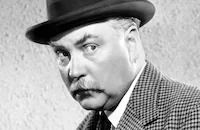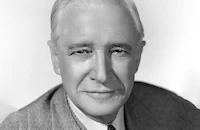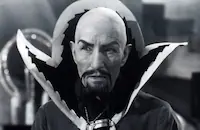The Trail of the Lonesome Pine
Cast & Crew
Henry Hathaway
Sylvia Sidney
Henry Fonda
Fred Macmurray
Fred Stone
Nigel Bruce
Film Details
Technical Specs

Synopsis
For years the Falins and Tollivers, hill families of Kentucky, have been feuding for reasons long forgotten. As another generation upholds the vengeful "code of the Lonesome Pine," city engineer Jack Hale comes to mine the coal on their land and bring the railroad to the area. When Hale first arrives at the Tolliver home, he finds Dave, a visiting nephew, dying of gangrene and saves his life. Dave plans to marry his cousin June, but she quickly becomes infatuated with the educated Hale. Judd Tolliver refuses to sign Hale's contract when he learns the railroad will cross Falin land, but acquiesces when Hale promises financial prosperity for his indigent family. June visits Hale frequently with her young brother Buddy, who idolizes the engineer. When Hale encourages June to get an education, she insists on following him into Gaptown, hoping to become sophisticated there. Dave, believing Hale's business deals are a subterfuge for stealing June, goes after the couple with a rifle, but comes into trouble with the Falins, who wait for him in Gaptown. After defending himself against Dave, Hale fights the Falins, while Dave escapes with June. When June refuses to return home, Hale sends her to his sister's home in Louisville. As winter descends upon the hills, Buddy learns the alphabet from Hale, but Dave, resistant to change, leaves the Tollivers. When the Falins dynamite the bridge to the mine, Buddy is accidentally killed, and June returns for the funeral. Hale then swears his love for June, who is now the sophisticated lady she always had wanted to be, but when he refuses to avenge Buddy's death except through the law, she rebukes him. Dave, who also has returned for Buddy's funeral, then goes to the Falins' unarmed, and Buck Falin, the father, apologizes to Dave for Buddy's death. When he leaves, however, Wade Falin, who is still angry about Dave's earlier murder of his brother, shoots him in the back. Before carrying Dave home, Buck wounds Wade. After Dave tells his aunt and uncle he fell on his own gun, the fathers make peace before he dies, leaving June free to marry Hale.

Director

Henry Hathaway
Cast

Sylvia Sidney

Henry Fonda

Fred Macmurray

Fred Stone

Nigel Bruce

Beulah Bondi

Robert Barrat
Spanky Mcfarland

Fuzzy Knight
Otto Fries

Samuel Hinds

Alan Baxter

Fern Emmett

Richard Carle

Henry Kleinbach
Philip Barker
Robert Kortman
Frank Rice

Charles Middleton
Clara Blandick

Irving Bacon
John Larkin
Ricca Allen
Margaret Armstrong
Powell Clayton
George Ernest
Norman Willis
Ed Le Saint
Hank Ball
Fred Burns
Bud Geary
James Welch
John Beck
Jim Corey

William Mccormick
Charlotte Wynters
Hilda Vaughn
Russ Powell
Sr. Frank Mcglynn
Lowell Drew

Lee Phelps
Jack Curtis
Betty Farrington

Jim Burke
Tuffy, A Dog
Crew
Louis Alter
Robert Bischoff
Robert C. Bruce
Harry Carroll
[w.] Howard Greene
Hugo Grenzbach
Rupert Hughes
Grover Jones
Natalie Kalmus
Horace Mccoy
Sidney D. Mitchell
Boris Morros
Richard Talmadge
Helen Taylor
Harvey Thew
Alexander Toluboff
Adolph Zukor

Film Details
Technical Specs

Award Nominations
Best Song
Articles
The Trail of the Lonesome Pine - Henry Fonda in THE TRAIL OF THE LONESOME PINE on DVD
Becky Sharp (1935), released eight months earlier and well-known as the first 3-color feature, had a plodding story in service to its bright, even garish color. Trail uses naturalistic color in service to its interesting story and characters and is all the more effective for it. The story concerns two rural Kentucky families who have been feuding for generations and a railroad engineer (Fred MacMurray) who arrives to mine for coal and bring a railroad through their properties. The daughter in one of the families (Sylvia Sidney) is supposed to marry her cousin (Henry Fonda) but falls for MacMurray and his educated urban charms, setting up a love triangle that meshes well with the feud and mining plots.
Rounding out the very good cast are an unlikely Nigel Bruce as MacMurray's business partner, Beulah Bondi, Samuel Hinds, "Spanky" McFarland (of "Our Gang" fame), and Fuzzy Knight, who wanders through the story observing and commenting on all the action and singing songs, including the Oscar-nominated "A Melody From the Sky." McFarland plays Sylvia Sidney's little brother in a pivotal role, and he is terrific. This is a very rare appearance for the tyke outside the "Our Gang" films during the time he was making them. Bondi and Hinds, incidentally, later played James Stewart's parents in It's a Wonderful Life (1946).
The actors, under Henry Hathaway's direction, do an admirable job in making these characters more than mere hillbillies. That word implies clichéd characters, but these are more dignified and three-dimensionally drawn. They have real feelings -- hurts, ambitions and enthusiasms -- that are well portrayed by a cast that is more impressive than the material itself.
But the real story here is the color. Most shots are dominated by muted browns, greens, golds and yellows. Instead of filling the frame with colorful objects, as Becky Sharp and other Technicolor short subjects had done, the makers of Trail were going for naturalism. One writer has noted that even red-and-black checkered shirts were not allowed on the characters for fear they would be seen as simply there to show off their color. There are some brief reds and oranges in sunset shots and in the abundant autumn leaves, sometimes reflected in a lake, and there are muted reds in an indoor wooden bar, but mainly Trail saves its most intense color for two sequences: a fire scene that is stretched out via editing to let the massive orange flames serve to powerful emotional effect, and a delirious little sequence involving colored pencils and a black-and-white photo of Sylvia Sidney. (It makes sense, sort of, when you see it.) By using more natural color the rest of the time, the film makes these moments stand out potently.
Film historian Scott Higgins, in his essential recent book Harnessing the Technicolor Rainbow: Color Design in the 1930s, writes that in Trail, "Manipulation of light, rather than color, proves the primary tool." Because the colors are muted, Higgins says, the distinctions between light and dark have more power here than in Becky Sharp. And, Higgins continues, critics took notice of the way Trail "properly integrated the new technology into a solid dramatic context." As Variety noted in 1936: "What Becky Sharp's significance was supposed to portray is actually promulgated by Lonesome Pine. It is evidence that color can be utilized as a forceful complement to cinematic entertainment providing the basic story ingredients are sturdy. Pine doesn't permit the color appeal to subjugate the primary phase of any film entertainment."
Higgins also writes that Paramount promoted the film with "unprecedented full-page color advertisements in the nation's leading newspapers." The result was "the first truly successful three-color feature." Indeed, Trail of the Lonesome Pine was among the top five box-office draws of 1936, and its success led to a spate of outdoor Technicolor films like Ramona (1936), God's Country and the Woman (1937) and Valley of the Giants (1938).
The Trail of the Lonesome Pine is newly out on DVD as part of Universal's Backlot Series of catalogue titles. There are no extras, but the picture quality is sublime thanks to a fine restoration. Serious movie fans will definitely want to look at this title for its landmark use of color; more casual fans will still enjoy it.
A final note: The Trail of the Lonesome Pine makes for an interesting comparison with Track of the Cat, William Wellman's eerie 1954 film that was shot in color but in which very little color can be found. That picture, too, is concerned with dysfunctional family dynamics, is set in the wilderness, and even features Beulah Bondi (in one of her most memorable performances). Wellman shot it essentially as a black-and-white film on color stock, with very limited use of reds. Track, which is available on DVD, is far more stylized than Trail, however. While Trail tones down the color for purposes of realism, Track fades it out almost completely for purposes of abstract metaphor.
For more information about The Trail of the Lonesome Pine, visit Universal Home Entertainment. To order The Trail of the Lonesome Pine, go to TCM Shopping.
by Jeremy Arnold

The Trail of the Lonesome Pine - Henry Fonda in THE TRAIL OF THE LONESOME PINE on DVD
Quotes
Trivia
The first film to be shot in Three-Strip Technicolor outside of a studio environment (on location).
Notes
This film was shot on location in Chatsworth, at Big Bear (in the San Bernardino Mountains), and at the Santa Susana Pass in CA. According to news items in Daily Variety, shooting at Big Bear took place in mid-October 1935, and the crew began four all-night sessions of exterior shooting at Santa Susana Pass on December 5, 1935. The onscreen foreword to this film outlines the feud between the "Falins" and the "Tollivers," "shut-in valley people of the mountains of America." Novelist Rupert Hughes was commissioned by Walter Wanger to write the foreword. In a prologue, a Falin-Tolliver shoot-out, which occurs during the birth of "June Tolliver," is depicted. A Los Angeles preview for this film on February 18, 1936 was 110 minutes long; the New York premiere the following day was only 100 minutes. The New York and Miami premieres of this film occurred within two days of each other, and each boasted record attendance. This film was the first feature-length outdoor film to be shot in three-strip Technicolor. A contemporary New York Times review states: "We can no longer doubt the inevitability of the color film," while Motion Picture Herald called the film "a Wow!" saying the Westwood preview received the "greatest burst of applause heard in years." Contemporary reviews mention the poor quality of the color blue in the film, but color designer Alexander Toluboff stated in an article in Motion Picture Herald on January 18, 1936 that the sky's natural color appeared artificial in the film because it was naturally "too blue." A Motion Picture Herald ad lists Toluboff as art director. An article by director of photography Robert C. Bruce in Film Daily on January 23, 1936 states that for close-ups of the film's stars, the cameramen had to do all their work before three p.m. because after that hour, when the sun was low in the sky, it cast a yellowish tinge on actors' faces. The Call Bureau Cast Service credits Norman Willis as playing "Old Dave" in the prologue, although Film Daily and New York Times credit Frank McGlynn, Jr., and Motion Picture Herald credits Frank McGlynn, Sr. in the role. McGlynn, Sr. is also credited in the role of a preacher by the Call Bureau. According to an article in the New York Times on March 29, 1936, the funeral scene in the film was eliminated by censors because the minister recited "The Lord's Prayer." A May 16, 1936 Hollywood Reporter news item states that Australian censors cut the entire burial scene (nearly half a reel of footage) from the film. According to Hollywood Reporter, this film was renamed Song of the Forest People for its release in Sweden. John Fox, Jr.'s novel was adapted into a play of the same title by Eugene Walter (New York, 29 January 1912) and was the source for three other films of the same title: one produced by Broadway Picture Producing Co. in 1914, starring Dixie Compton; a second made by Jesse L. Lasky Feature Play Co. in 1916, directed by Cecil B. DeMille and starring Charlotte Walker, who also starred in the stage version (see AFI Catalog of Feature Films, 1911-20; F1.4537 and F1.4538); and a third made by Famous Players-Lasky in 1923, directed by Charles Maigne and starring Mary Miles Minter and Antonio Moreno (see AFI Catalog of Feature Films, 1921-30; F2.5810).

Miscellaneous Notes
Released in United States 1936
Released in United States 1936













